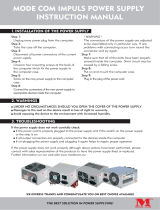
4 Removal and replacement procedures – small form factor (SFF) chassis .......................................................... 18
Preparation for disassembly ............................................................................................................................... 18
Access panel ......................................................................................................................................................... 19
Front bezel ........................................................................................................................................................... 19
Front bezel security ............................................................................................................................................. 20
Slim optical drive bezel blank .............................................................................................................................. 21
Dust lter ............................................................................................................................................................. 22
Memory ................................................................................................................................................................ 24
DIMMs ................................................................................................................................................ 24
DDR4-SDRAM DIMMs ......................................................................................................................... 24
Populating DIMM sockets .................................................................................................................. 24
Installing DIMMs ................................................................................................................................ 25
Expansion card ..................................................................................................................................................... 27
Drives ................................................................................................................................................................... 31
System board connections ................................................................................................................ 32
Drive positions ................................................................................................................................... 33
Installing and Removing Drives ........................................................................................................ 33
Removing a 9.5mm slim optical drive ............................................................................ 35
Installing a 9.5mm slim optical drive ............................................................................. 36
Removing and replacing a primary 3.5-inch hard drive ................................................. 37
Removing a secondary 3.5-inch hard drive .................................................................... 39
Installing a secondary 3.5-inch hard drive ..................................................................... 40
Removing a 2.5-inch hard drive ...................................................................................... 42
Installing a 2.5-inch hard drive ....................................................................................... 44
Drive power cable ................................................................................................................................................ 47
Small bae .......................................................................................................................................................... 48
Fan bae ............................................................................................................................................................. 49
Hood lock ............................................................................................................................................................. 50
Front I/O assembly ............................................................................................................................................... 52
Power switch ........................................................................................................................................................ 54
Speaker ................................................................................................................................................................ 56
Fan sink ................................................................................................................................................................ 57
Processor ............................................................................................................................................................. 58
Power supply ....................................................................................................................................................... 60
System board ....................................................................................................................................................... 62
System board callouts ....................................................................................................................... 63
Using the Small Form Factor Computer in a Tower Orientation ......................................................................... 65
5 Computer Setup (F10) Utility ........................................................................................................................ 66
Computer Setup (F10) Utilities ............................................................................................................................ 66
Using Computer Setup (F10) Utilities ................................................................................................ 66
vi





















